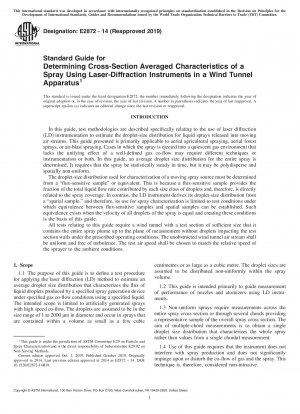ASTM E2872-14(2019)
Standard Guide for Determining Cross-Section Averaged Characteristics of a Spray Using Laser-Diffraction Instruments in a Wind Tunnel Apparatus
- Standard No.
- ASTM E2872-14(2019)
- Release Date
- 2019
- Published By
- American Society for Testing and Materials (ASTM)
- Status
- Replace By
- ASTM E2872-14(2024)
- Latest
- ASTM E2872-14(2024)
- Scope
- 1.1 The purpose of this guide is to define a test procedure for applying the laser diffraction (LD) method to estimate an average droplet size distribution that characterizes the flux of liquid droplets produced by a specified spray generation device under specified gas co-flow conditions using a specified liquid. The intended scope is limited to artificially generated sprays with high speed co-flow. The droplets are assumed to be in the size range of 1 to 2000 µm in diameter and occur in sprays that are contained within a volume as small as a few cubic centimetres or as large as a cubic metre. The droplet sizes are assumed to be distributed non-uniformly within the spray volume. 1.2 This guide is intended primarily to guide measurement of performance of nozzles and atomizers using LD instruments. 1.3 Non-uniform sprays require measurements across the entire spray cross section or through several chords providing a representative sample of the overall spray cross section. The aim of multiple-chord measurements is to obtain a single droplet size distribution that characterizes the whole spray rather than values from a single chordal measurement. 1.4 Use of this guide requires that the instrument does not interfere with spray production and does not significantly impinge upon or disturb the co-flow of gas and the spray. This technique is, therefore, considered non-intrusive. 1 This guide is under the jurisdiction of ASTM Committee E29 on Particle and Spray Characterization and is the direct responsibility of Subcommittee E29.02 on Non-Sieving Methods. Current edition approved Oct. 1, 2019. Published October 2019. Originally approved in 2014. Last previous edition approved in 2014 as E2872 – 14. DOI: 10.1520/E2872-14R19. Copyright © ASTM International, 100 Barr Harbor Drive, PO Box C700, West Conshohocken, PA 19428-2959. United States This international standard was developed in accordance with internationally recognized principles on standardization established in the Decision on Principles for the Development of International Standards, Guides and Recommendations issued by the World Trade Organization Technical Barriers to Trade (TBT) Committee. 1 1.5 The computation of droplet size distributions from the light-scattering distributions is done using Mie scattering theory or Fraunhofer diffraction approximation. The use of Mie theory accounts for light refracted through the droplet and there is a specific requirement for knowledge of both real (refractive) and imaginary (absorptive) components of the complex index of refraction. Mie theory also relies on an assumption of droplet homogeneity. The Fraunhofer diffraction approximation does not account for light refracted through the droplet and does not require knowledge of the index of refraction. 1.6 The instruments shall include data-processing capabilities to convert the LD scattering intensities into droplet size distribution parameters in accordance with Practice E799 and Test Method E1260. 1.7 The spray is visible and accessible to the collimated beam produced by the transmitter optics of the LD instrument. The shape and size of the spray shall be contained within the working distance of the LD system optics as specified by the instrument manufacturer. 1.8 The size range of the LD optic should be appropriate to the spray generation device under study. For example, the upper bound of the smallest droplet size class reported by the instrument shall be not more than 1⁄4 the size of DV0.1. 1.9 The values stated in SI units are to be regarded as standard. No other units of measurement are included in this standard. 1.10 This standard may involve hazardous materials, operations, and equipment. This standard does not purport to address all of the safety concerns, if any, associated with its use. It is the responsibility of the user of this standard to establish appropriate safety, health, and environmental practices and determine the applicability of regulatory limitations prior to use. 1.11 This international standard was developed in accordance with internationally recognized principles on standardization established in the Decision on Principles for the Development of International Standards, Guides and Recommendations issued by the World Trade Organization Technical Barriers to Trade (TBT) Committee.
ASTM E2872-14(2019) Referenced Document
- ASTM E1260 Standard Test Method for Determining Liquid Drop Size Characteristics in a Spray Using Optical Nonimaging Light-Scattering Instruments
- ASTM E1620 Standard Terminology Relating to Liquid Particles and Atomization*, 2022-02-01 Update
- ASTM E799 Standard Practice for Determining Data Criteria and Processing for Liquid Drop Size Analysis
ASTM E2872-14(2019) history
- 2024 ASTM E2872-14(2024) Standard Guide for Determining Cross-Section Averaged Characteristics of a Spray Using Laser-Diffraction Instruments in a Wind Tunnel Apparatus
- 2019 ASTM E2872-14(2019) Standard Guide for Determining Cross-Section Averaged Characteristics of a Spray Using Laser-Diffraction Instruments in a Wind Tunnel Apparatus
- 2014 ASTM E2872-14 Standard Guide for Determining Cross-Section Averaged Characteristics of a Spray Using Laser-Diffraction Instruments in a Wind Tunnel Apparatus
